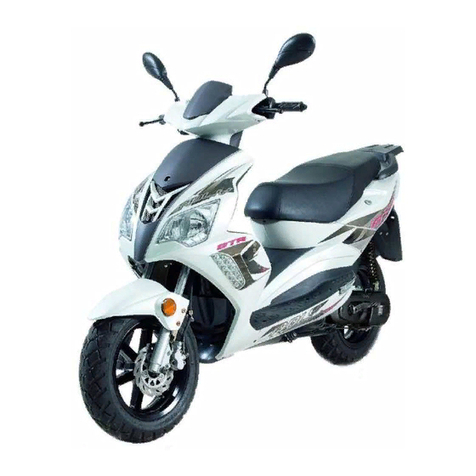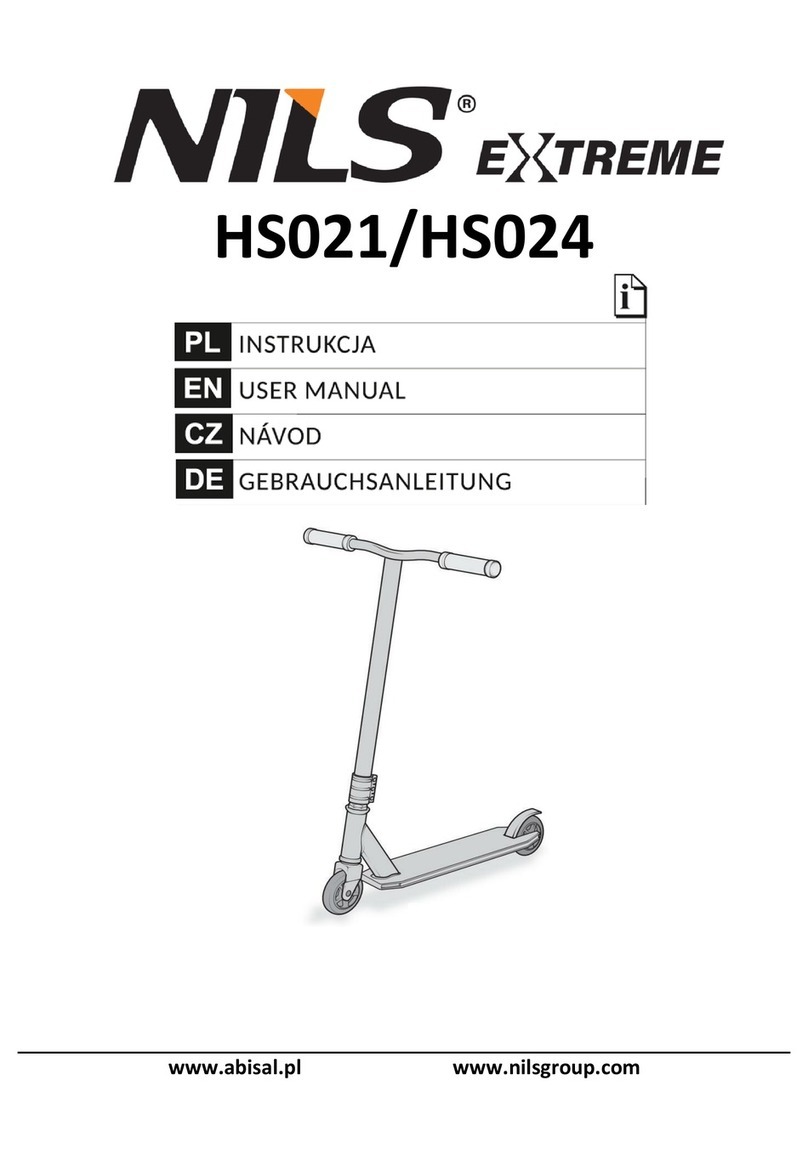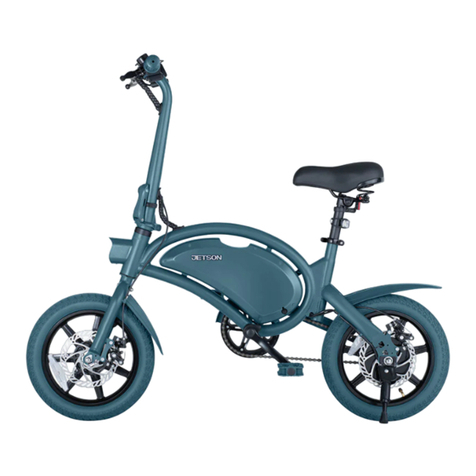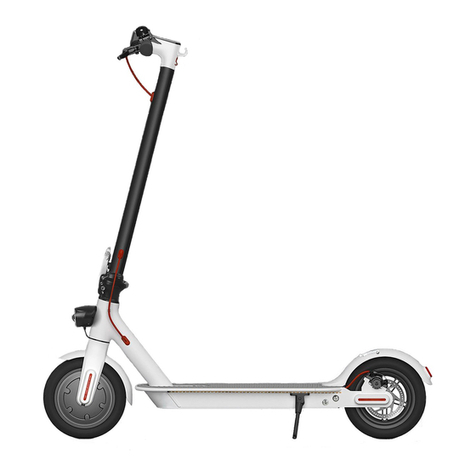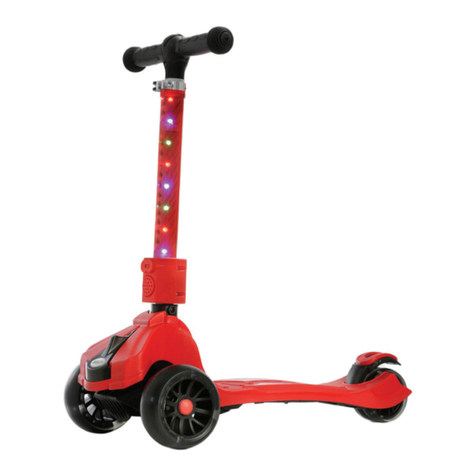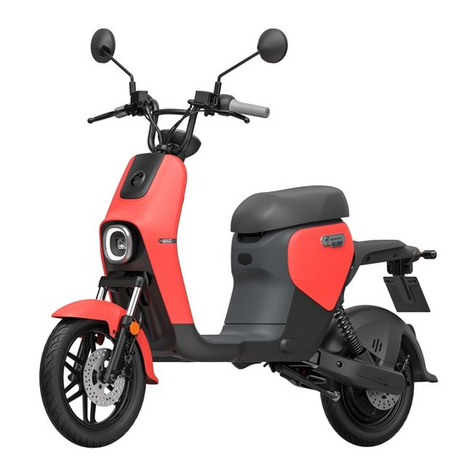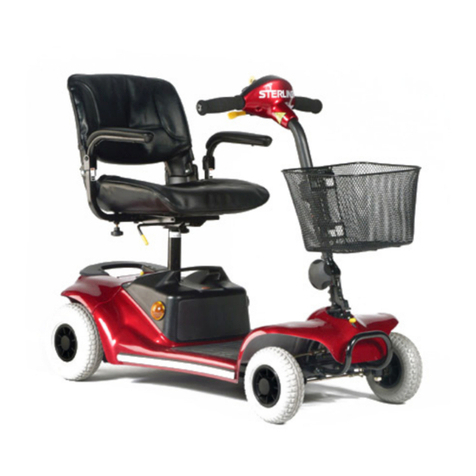SEEMARK Y-22 User manual

2
Contents
1. Introduction
2. Profile of the auto balance scooter
3. Control device and components of the auto balanced scooter
4. Operational settings
5. Driving of the two-wheeled balanced scooter
6. Battery Charging
7. Maintenance
8. Matters needing attention
9. Technical parameters
1. Introduction
This "user manual" is suitable for the 22” Cross Country model of the two-wheeled auto
balanced scooter. However because the manufacturer is constantly adding improvements,
some functionality will vary slightly depending on the year of manufacture.
The contents and technical specifications contained in this manual are subject to a valid
license at the time of printing. However, our company reserves the right to terminate the use
and the right to change specifications or design without prior notice and without incurring
any obligations.
This manual outlines safeguards, lawful rights and interests. In order to understand your
rights and responsibilities, please read this "user manual” carefully. Please ensure that your
auto balance scooter is maintained in accordance with this "user manual" and that
appropriate personal protective equipment is always worn. Always contact your supplier /
service agent for professional repairs or spare parts.
A warranty card is included with this manual. Please populate the various entries and retain
for future reference. Warranty is 12 months from date of purchase and the device must be
returned to the supplier at the buyer’s expense should a claim be made.
We sincerely wish you much joy as you use your auto balance scooter for work or pleasure.
For the safety of yourself and others and in order to ensure the auto balanced scooter
provides you with a pleasurable experience, we must insist that you read this manual
carefully. Please ensure this manual is kept in a secure place for future reference.
Some notes about safety
Use by minors is strictly prohibited.
Local traffic and Council regulations must be obeyed.
A helmet and personal protective equipment (safety clothes) must be worn.
Follow the operating and maintenance guides carefully described in the "user
manual".

3
If an accident or injury occurs as a result of any failure to obey this manual, all
responsibility and warranty will be void. Please drive carefully.
Eliminating all the risks associated with the operation and maintenance of the auto
balanced scooter is unrealistic and impossible, so the operator is required to make
timely and accurate judgments in order to prevent injury or death. Please pay
attention to the safety of yourself and others at all times. All responsibility for the
safety of the operator or the public rests with the purchaser and or operator.
This manual contains important safety information——please read it carefully.
2. Profile of the auto balanced scooter
The major operating principle of the two-wheeled auto balanced scooter is based on the
"dynamic stability", which is the automatic balance of the vehicle itself. The precision
high-speed central microprocessor will calculate the appropriate commands to drive the
motor(s) to achieve a result of balance; after the precise posture state of the scooter is
determined using the built-in solid-state gyroscope. Because it is a parallel two wheel design,
this product is different from traditional two-wheel and dual spindle scooters.
The scooter is driven by a maintenance free lithium battery which can be charged repeatedly.
The vehicle does not require brakes or throttle while operating. While the driver leans
forward, the auto balance scooter will move forward. While the driver’s body is upright, the
auto balance scooter will stop. Using the principle of dynamic equilibrium, the centre of the
gravity changes until it can achieve a balance while the body moves. The two-wheel auto
balanced scooter copies the function of human legs to create balance via rotation of the
wheels either forward or backward. The operating cost is low as it moves quietly and
conveniently. In the case of a full charge it can typically drive three hours if fitted with one (1)
battery, (6hrs / 2 batteries; 9 hrs / 3 batteries) continuously before requiring recharging. The
trip distance is related to the road and terrain that you are driving on and driving on the
grass and or slopes will consume more power.
Warning instructions:
Warning - Serious injury or death may occur in the event of an accident with this scooter. A
helmet and body protection must be worn to minimize injury for in the event that an
accident occurs.
Neither the manufacturer, the importer nor any sales agents accept responsibility for any
injury sustained whilst riding this device. All liability rests with the operator.
Warning - Auto balanced scooters may not be approved for use on public roads or footpaths
in your area. It is the operator’s responsibility to check with local authorities.
3. Control device and components of the two-wheel balanced scooter
a) Steering lever
b) Indicator
c) Foot pedal

4
d) Power switch & light switch
e) Wheel motor, hub & tyre
f) Charging socket
a) The steering lever
The steering lever is used to control the two-wheel balanced scooter to turn left and
turn right. It can cause the scooter to turn around and rotate 360 degrees. The
steering lever also plays a role of support; it has a supplementary role to the body
balance.
The steering lever length may be adjustable on some models.
Steering lever
Indicator
Foot pedals (2)
Power switch & light switch
Wheel motor, hub & tyre
Charging socket

5
The steering lever should be locked after fitting by tightening the appropriate stud
with hand tools.
The steering lever can be removed to aid transportation.
b) The Indicator
The digital indicator will provide functional information to aid in setting and
operating the scooter.
c) The foot pedals
The foot pedals monitor upper and lower activity and house the built-in safety
switches.
The scooter will not operate if the operator is not standing on the foot pedals.
If the driver suddenly leaves the foot pedals, the switches under the foot pedals will
reset and the auto balanced scooter will automatically stop after 2 seconds.
d) The power and light switches
The power switch is used to turn the battery supply on or off. When this switch is on
you can complete the initial setting of the two-wheel auto balanced scooter.
The light switch will turn the lights on and off.
e) Wheel motor, hub and tyre
Each wheel hub houses a 2,000Watt electric motor which drives the scooter forward
or backward.
Tyre pressures must be maintained to ensure the scooter operates correctly.
f ) Charging socket
The battery charger must be connected to this socket and mains power turned on to
enable charging of the battery(s).

6
4. Operational settings
All operational adjustments and settings to this scooter are preset but can be modified to
suit the owner/operators personal preferences using a smartphone, either android or iPhone.
Each scooter has a “QR Code” attached (and shown below) which can be scanned with the
smartphone to download the appropriate “mROBOT” app. Once the app is opened on the
smartphone, the operator can “search” for and select the device/scooter before making
personal choices to the scooters operational settings.
Android QR Code
iPhone QR Code
5. Driving the scooter
a. With one hand placed on the steering rod and whilst keeping the pedal level, turn on
the power switch. Then clasping the handles of the balanced scooter with your hands,
step on to the car.
b. It may be difficult to stand up if the preset pedal position is not suited to your body
dimensions and weight. This pedal position can be adjusted using your smartphone as
discussed in Item 4 above.

7
The driving of the balanced scooter is totally different from the traditional auto operation of
other vehicles. There isn’t a traditional brake, accelerator or transmission system. When you
drive the vehicle, wear protective clothing, helmet, knee pads, and elbow pads. If you drive
the two-wheel auto balanced scooter for the first time, you must read the following guidance
carefully or be trained by an experienced user.
Warning - Driving the two-wheel auto balance scooter may be very addictive, once you
experience the fun of it, you may often look for opportunities to drive it but be careful that
you do not become fatigued and incapable of making safe decisions.
1. Getting on - Stand on the auto balanced scooter by placing both hands on the handles and
then both feet on to the pedals. After stepping down on the pedals, the two-wheel auto
balanced scooter will start computing to keep balance. You will feel the scooter trying to
maintain a balance position.
The recommended order for getting on to the scooter is as follows: left hand - right foot; left
foot - right hand; or right hand - left foot; right foot - left hand.
2. Driving forward - When the body leans forwards slowly (center of gravity moves forward),
the two-wheel balanced scooter begins to travel straight forward. The speed of the scooter is
controlled by the angle of the forward lean. If the degree is bigger the speed is faster.
Conversely if the degree is smaller, the speed is slower. Lean forward slowly to achieve
smooth straight line acceleration. Lean forward quickly to achieve faster acceleration.
3. Reversing - We do not recommend that you reverse the auto balance scooter backwards.
It may be unsafe to do so. The turning radius of the two-wheel balanced scooter is zero,
therefor it can easily spin around 360 degrees. To turn around 180 degrees it is
recommended that you lean slightly back to slow and stop the scooter before attempting to
turn. Smoothly leaning backward is helpful to slow down or stop.
Grasp the handles and lean slightly forward like pushing a shopping trolley. Lean backward to
slow down or stop.
4. Turning - The turning of the two-wheel auto balanced scooter occurs by leaning the
steering lever to the left or to the right. The body must cooperate to turn to the left or to the
right at the same time by leaning in to the direction of travel.

8
Turning during travel is accomplished through the steering stem and body coordination. To
turn left, the steering lever should have a smooth swing to the left, leaning to the left in the
body at the same time. The size of the turning radius is largely dependent on the swing angle
of the steering lever.
6. Driving in wet weather - The basic two-wheel auto balanced scooter does not have
waterproof capability for driving in rain or water. When the scooter is wet, damage to the
motor and electric devices may occur which may cause abnormal operation.
The basic model of the two-wheel auto balanced scooter cannot be used in snow and ice.
The basic two-wheel auto balanced scooter is equipped with night lights which can be
switched on/off when required.
6. Battery Charging
It is recommended that caution be exercised to ensure the batteries are recharged before
the power falls below 10%. First it is important to turn off the power switch, then connect
the battery charger supplied with the scooter.
The battery charger has two lights; the red represents charging and the green represents
charging complete. The input voltage of the charger is 220-240V. The output voltage varies
depending on the particular model of scooter. The charging time is generally around six
hours to complete, at which time the green light will turn on in the battery charger. The

9
charger will become hot during charging and must be kept in a well-ventilated place.
7. Maintenance
This section covers basic maintenance. Should other problems be encountered it is
recommended that the scooter be serviced by the authorized dealer.
1. Power Switch - Please shut off the power switch when the scooter is not used.
2. Battery - The two-wheel auto balanced scooter uses maintenance free batteries. Charging
is required when indicated and generally takes around 6 hours at which time the green lamp
will glow within the battery charger. The longest charging time should not be more than 15
hours. The auto balanced scooter also should be charged when it has not been used in a long
time. Excessive discharge and recharge will have an impact on the life of battery.
(Suggestion: charging is necessary when the scooter is not used in a month)
3. Tyres - The normal pressure is 80 kpa. It is necessary to check the tyre pressure regularly.
Under or over inflation can cause uneven tyre wear and affect the maneuverability and
driving comfort of the scooter. Under-inflation can also increase the power usage. It is
recommended that the tyres be checked daily for trauma, foreign bodies and other abrasions.
The tyres should be replaced if wear or damage is excessive.
4. Cleaning –The auto balance scooter should be kept clean with a damp cloth. Do not use
any corrosive chemicals such as gasoline. Do not flush the scooter with water.
5. The warranty is 12 months from date of purchase. This is a “back to base” warranty thus it
is the owners responsibility to deliver and pick-up the scooter from the supplier.
6. It is the purchaser’s responsibility to populate the warranty card at the time of purchase
and to update the card during maintenance. Please present the warranty card to the service
agent if repairs are necessary. If the warranty card is not made available, the warranty will
expire after 13 months from the date of production.
7. Beyond the warranty period you may obtain parts from the authorized dealer or
alternatively return the auto balance scooter to the authorized dealer for repair if needed.
8. Matters needing attention
1. The scooter will come with operating parameters preset however the purchaser/operator
may set the desired pedal position, steering sensitivity and speed settings using the “mRobot
app”on their smartphone as discussed in chapter 4.
2. The two-wheel balanced scooter should be stored upright and the power switch turned off
when not in use.
3. The power switch should be turned off immediately if the scooter is placed under water
and the scooter disassembled and dried. Failure to comply with this requirement may result
in serious damage to the wheel motors and electrical circuitry. The weight of the scooter is
about 50 kg and in the absence of power it can be pushed/pulled home.

10
9. Technical parameters
Battery
Lithium 72V 9Ah
Option 2 batteries 18Ah
Option 3 batteries 27Ah
Length width height
83cm×46cm×600cm (Package 99cmL x 56cmW x 66cmH)
The vehicle weight
60kg (Packaged 85kg)
Power
1,000 Watt brushless dc motors contained within each wheel
Operational settings
Adjusted with smartphone and “mRobot app”
Tyre
22 inches vacuum and puncture-proof tyres (alloy wheels)
Handlebar height
80 - 110cm
Maximum load
200kg
Maximum speed
20km/h
Maximum travel distance
30km / 1 x battery
60km / 2 batteries
90km / 3 batteries
Pedal height
26cm
Ground clearance
13cm
Turning circle
0m
Maximum climbing angle
≤30 degree
Tyre air pressure
80kpa
Power indicator
Digital readout
A full charge time
6 hours
Package size
99cm (length) ×56cm (width) ×66cm (height) & 85kg weight

11
The warranty card
To be completed and retained by the purchaser
The record of the scooter body
Customers name
Purchase date
Contact address
Product model
Invoice number
Serial number
The sales agent
SEEMARK (AUSTRALIA) PTY LTD
Maintenance record
Maintenance date
Maintenance content
Remarks
The product list
No
Product name
unit
quantity
No
Product name
unit
quantity
1
Auto Balance Car
Each
1
8
2
Battery charger
Each
1
9
3
Instruction Manual
Each
1
10
4
Warranty card
Each
1
11
5
Helmet
Each
optional
12
6
Protective Clothing
Each
optional
13
7
Golf Bag support frame
Each
optional
14

12
Product delivery acceptance certificate
To be completed and returned to supplier
The customer information registration form
The customer name
Contact address
Contact telephone
Purchase date
Invoice number
The product model
The Serial number
The scooter body color
The battery type
The sales agent
The product list
No
Product name
unit
Quantity
No
Product name
unit
Quantity
1
Auto Balance Car
Ea
8
Protective clothing
Ea
Optional
2
Battery charger
Ea
9
Protective frame
Ea
Optional
3
Instruction Manual
Ea
10
Bell
Ea
Optional
4
Warranty card
Ea
11
5
Golf bag support frame
Ea
Optional
12
6
Helmet
Ea
Optional
13
7
Flashing light
Ea
Optional
14
Please return this document once completed to:
SEEMARK (AUSTRALIA) PTY LTD
PO Box 151 Tahmoor NSW 2573 Australia
Email sales@seemark.com.au
This information will be retained by SEEMARK for future reference.
Table of contents
Popular Scooter manuals by other brands
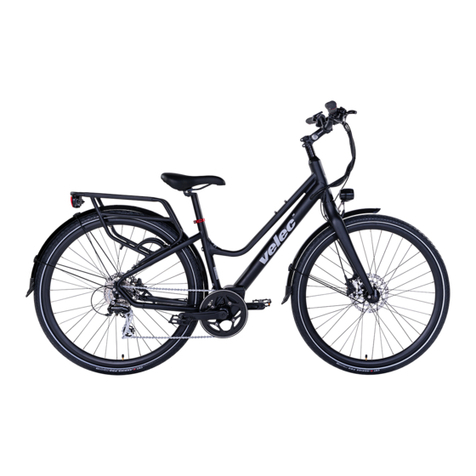
Velec
Velec CITI + owner's manual

Prime Karts
Prime Karts FATAL VISION ROADSTER Assembly Instructions and Maintenance Manual
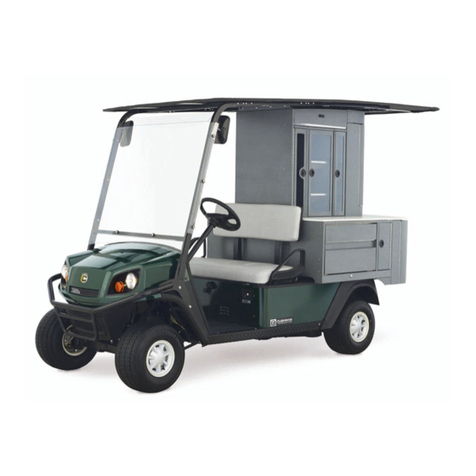
Cushman
Cushman Refresher fs2 owner's guide
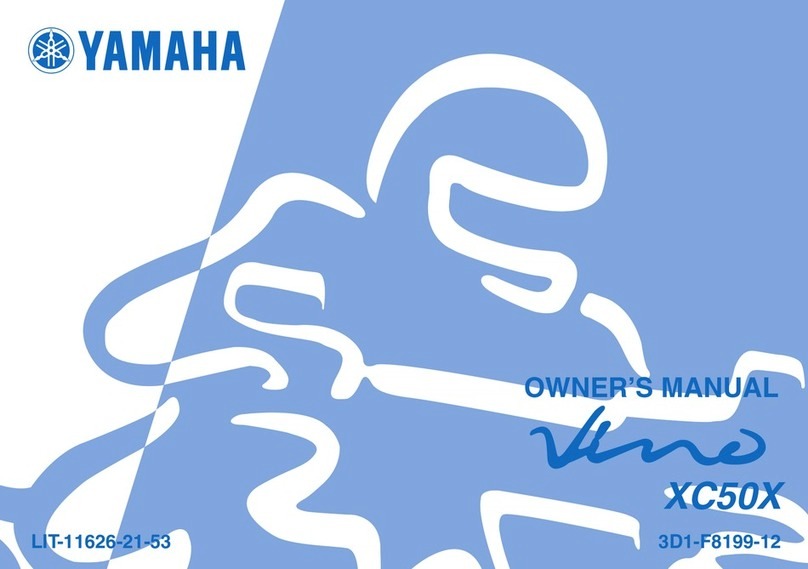
Yamaha
Yamaha VINO XC50X owner's manual
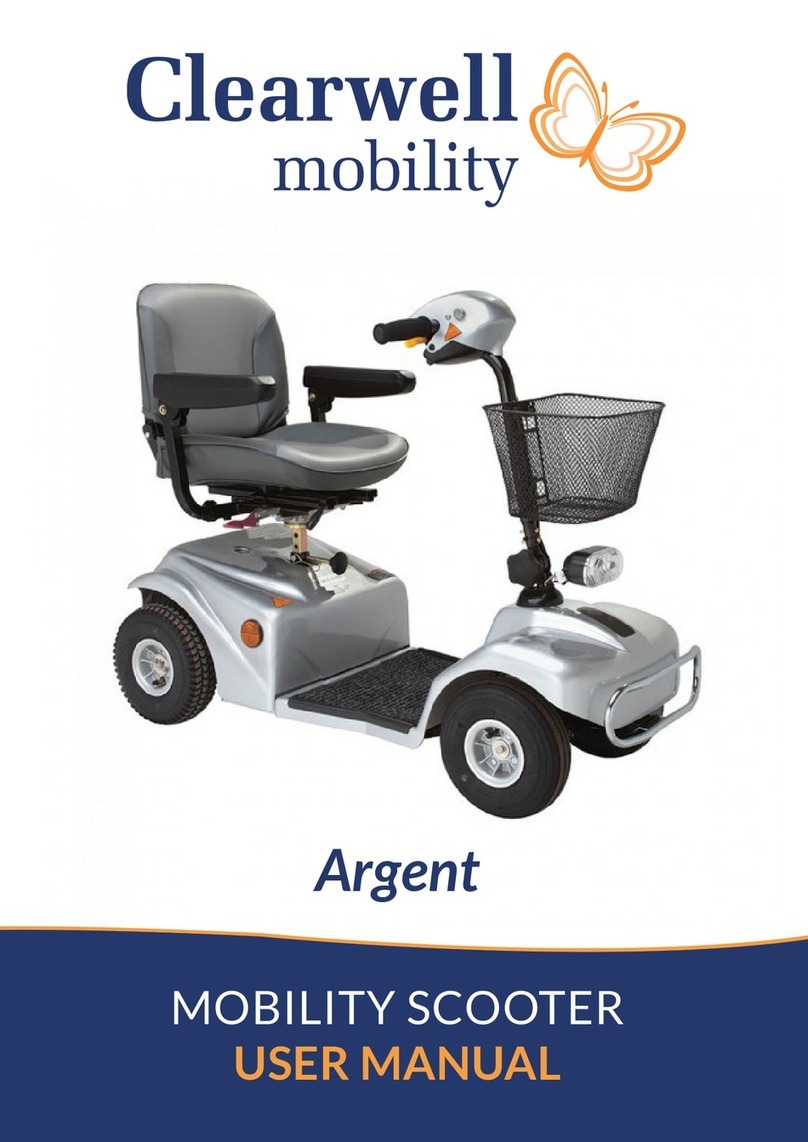
Clearwell Mobility
Clearwell Mobility Argent user manual

Roketa
Roketa Bahama-50 Installation instruction

